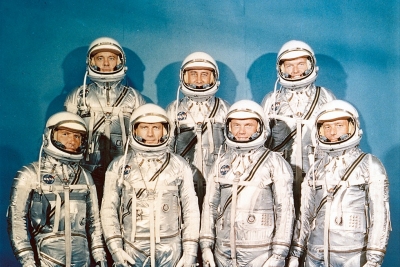
On May 15, 1963, the last mission of Project Mercury got under way. Astronaut Gordon Cooper closed out things in style as his flight stretched the capabilities of the Mercury spacecraft to its limits.
The Mercury Seven, also referred to as the Original Seven, were a group of seven astronauts selected to fly spacecraft for Project Mercury – the first human space flight program by the U.S. Even though there were some hiccups, the project, initiated in 1958, was largely successful in its three goals of operating a human spacecraft. investigating an astronaut’s ability to work in space, and recovering spacecraft and crew safely.
Youngest of the Mercury Seven
The final flight of Project Mercury took place in May 1963. The youngest of the Original Seven, astronaut Gordon Cooper, went on to become the first American to fly in space for more than a day during this mission.
Leroy Gordon Cooper Jr. was born in 1927 and served in the Marine Corps in 1945 and 1946. He was commissioned in the U.S. Army after attending the University of Hawaii.
He was called to active duty in 1949 and completed pilot training in the U.S. Air Force. He was a fighter pilot in Germany from 1950 to 1954 and earned a bachelor’s degree at the Air Force Institute of Technology in 1956. He served as a test pilot at Edwards Air Force Base in California until he was selected as an astronaut for Project Mercury. Cooper flew Mercury-Atlas 9, the last Mercury mission, which was launched on May 15, 1963. He called his capsule Faith 7, the number indicating his status as one of the Original Seven astronauts.
Conducts 11 experiments
Longer than all of the previous Mercury missions combined. Cooper had enough time in his hands to conduct 11 experiments. These included monitoring radiation levels, tracking a strobe beacon that flashed intermittently, and taking photographs of the Earth.
When Cooper sent back black-and-white television images back to the control centre during his 17th orbit, it was the first TV transmission from an American crewed spacecraft. And even though there were plans for Cooper to sleep as much as eight hours, he only managed to sleep sporadically during portions of the flight. After 19 orbits without a hitch, a faulty sensor wrongly indicated that the spacecraft was beginning re-entry. A short circuit then damaged the automatic stabilisation and control system two orbits later. Despite these malfunctions and the rising carbon dioxide levels in his cabin and spacesuit. Cooper executed a perfect manual re-entry.
Lands without incident Cooper had clocked 34 hours and 20 minutes in space, orbiting the Earth 22 times and covering most of the globe in the process. This meant that he could practically land anywhere in the globe, a potential pain point that the U.S. State
Department was nervous about. In fact, on May 1, 1963, the country’s Deputy Under Secretary fuel, venting gas that made the spacecraft roll, and more in what felt like a never-ending series during their eight-day mission. They, however, completed 122 orbits, travelling over 5.3 million km in 190 hours and 56 minutes, before safely making their way back to Earth.
After accumulating more than 225 hours in space, Cooper served as the backup command pilot of Gemini 12, which was launched in November 1966, and the backup command pilot for Apollo 10 in May 1969. By the time Cooper left NASA and retired from the Air Force in July 1970, human beings had set foot on the moon, further vindicating the Mercury and Gemini projects that Cooper had been involved with.
Picture Credit : Google




